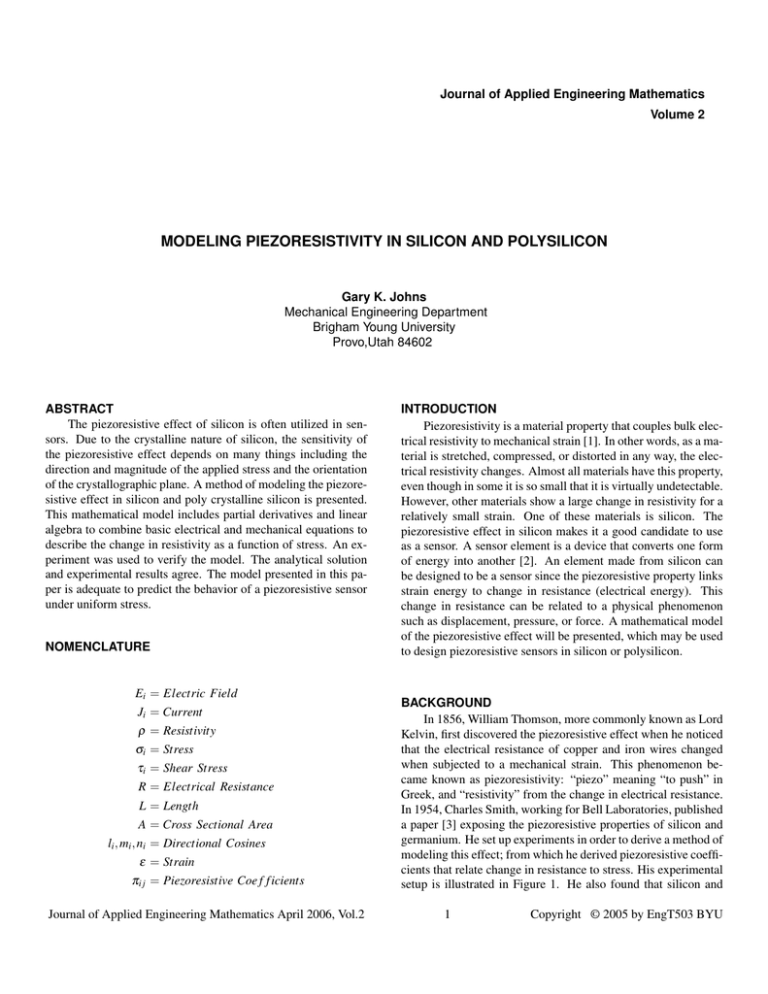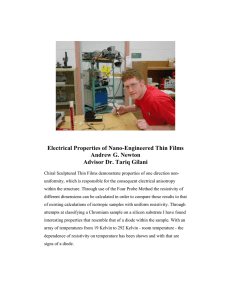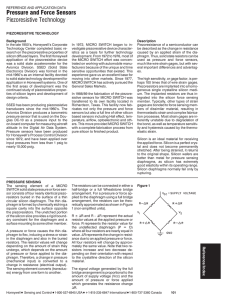modeling piezoresistivity in silicon and polysilicon
advertisement

Journal of Applied Engineering Mathematics Volume 2 MODELING PIEZORESISTIVITY IN SILICON AND POLYSILICON Gary K. Johns Mechanical Engineering Department Brigham Young University Provo,Utah 84602 ABSTRACT The piezoresistive effect of silicon is often utilized in sensors. Due to the crystalline nature of silicon, the sensitivity of the piezoresistive effect depends on many things including the direction and magnitude of the applied stress and the orientation of the crystallographic plane. A method of modeling the piezoresistive effect in silicon and poly crystalline silicon is presented. This mathematical model includes partial derivatives and linear algebra to combine basic electrical and mechanical equations to describe the change in resistivity as a function of stress. An experiment was used to verify the model. The analytical solution and experimental results agree. The model presented in this paper is adequate to predict the behavior of a piezoresistive sensor under uniform stress. NOMENCLATURE Ei = Electric Field Ji = Current ρ = Resistivity σi = Stress τi = Shear Stress R = Electrical Resistance L = Length A = Cross Sectional Area li , mi , ni = Directional Cosines ε = Strain πi j = Piezoresistive Coe f f icients Journal of Applied Engineering Mathematics April 2006, Vol.2 INTRODUCTION Piezoresistivity is a material property that couples bulk electrical resistivity to mechanical strain [1]. In other words, as a material is stretched, compressed, or distorted in any way, the electrical resistivity changes. Almost all materials have this property, even though in some it is so small that it is virtually undetectable. However, other materials show a large change in resistivity for a relatively small strain. One of these materials is silicon. The piezoresistive effect in silicon makes it a good candidate to use as a sensor. A sensor element is a device that converts one form of energy into another [2]. An element made from silicon can be designed to be a sensor since the piezoresistive property links strain energy to change in resistance (electrical energy). This change in resistance can be related to a physical phenomenon such as displacement, pressure, or force. A mathematical model of the piezoresistive effect will be presented, which may be used to design piezoresistive sensors in silicon or polysilicon. BACKGROUND In 1856, William Thomson, more commonly known as Lord Kelvin, first discovered the piezoresistive effect when he noticed that the electrical resistance of copper and iron wires changed when subjected to a mechanical strain. This phenomenon became known as piezoresistivity: “piezo” meaning “to push” in Greek, and “resistivity” from the change in electrical resistance. In 1954, Charles Smith, working for Bell Laboratories, published a paper [3] exposing the piezoresistive properties of silicon and germanium. He set up experiments in order to derive a method of modeling this effect; from which he derived piezoresistive coefficients that relate change in resistance to stress. His experimental setup is illustrated in Figure 1. He also found that silicon and 1 Copyright © 2005 by EngT503 BYU germanium are much more sensitive to the piezoresistive effect than most metals. In the 1960’s, silicon began to be used as a sensor on thin membranes by diffusing it on areas of the membrane that would experience the most stress in order to measure pressure. It was also doped on cantilever beams to enable measurement of other phenomena (see Figure 2). Since then, many sensors have been developed that are based on the piezoresistive effect of silicon. MODELING PIEZORESISTIVITY ALONG CRYSTAL AXES Modeling the piezoresistive effect of silicon requires linking equations related to the electrical properties of a material with equations describing the stress or strain and volumetric changes of a material. Starting with Ohm’s law (E = IR), the electric field vector of an anisotropic cubic crystal can be derived. It is related to the current vector by a resistivity tensor [4]. E1 ρ1 ρ6 ρ5 J1 E2 = ρ6 ρ2 ρ4 J2 E3 ρ5 ρ4 ρ3 J3 (1) The resistivity tensor is symmetric and is therefore made up of only six components. When the crystal is in an unstressed state, the resistivity components along the diagonal of the matrix, which represent the resistivity along the <100> axes of the cubic, are equal to each other. The other three components are also equal to each other and are 0. ρ1 = ρ2 = ρ3 = ρ, ρ4 = ρ5 = ρ6 = 0 (2) When the cubic is stressed, each component of resistivity changes. The new resistivity of each component in the resistivity tensor is ∆ρ1 ρ1 ρ ρ2 ρ ∆ρ2 ρ3 ρ ∆ρ3 = + ρ4 0 ∆ρ4 ρ5 0 ∆ρ5 ∆ρ6 0 ρ6 Figure 1. Charles Smith’s experimental setup Proof Mass R1 R4 Flexure R2 Side View Longitudinal Top View Transverse Top View (3) The link relating change in resistance to stress is the Π matrix. This is the matrix which Charles Smith worked to define. The experimental setup in Figure 1 shows how he derived the piezoresistive coefficients for silicon and germanium. The change in resistance is directly related to the stress on the object through these piezoresistive coefficients by Flexible Diaphragm R3 a) Figure 2. beams Top View 1 ∆ρi = [πi j ] [σ j ] ρ b) Piezoresistive sensor elements doped onto diaphragms and Journal of Applied Engineering Mathematics April 2006, Vol.2 (4) where the stresses relate to the stresses shown in Figure 3. σ1 , σ2 , and σ3 are along the axes of the cube and σ4 , σ5 , and σ6 map to the shear stresses τ1 , τ2 , and τ3 . With six stress components and six resistivity components, the π matrix must be a six-by-six matrix. Therefore, 36 π coefficients are required to populate the 2 Copyright © 2005 by EngT503 BYU MODELING PIEZORESISTIVITY IN ANY DIRECTION The above equations are used to model the piezoresistive effect of silicon in the direction of the crystal axes. However, it is often convenient to be able to model the piezoresistive effect along other directions as well. Two new π coefficients can be defined in terms of the original 3 π coefficients and an arbitrary direction. These two new π coefficients relate the change in resistance to the stress in the longitudinal direction (defined to be the same direction as the current flow) and the transverse direction (defined to be perpendicular to the current flow). πl and πt are πl = π11 + 2 (π44 + π12 − π11 ) l12 m21 + l12 n21 + m21 n21 πt = π12 − (π44 + π12 − π11 ) l12 l22 + m21 m22 + n21 n22 Figure 3. π11 π12 π12 0 0 0 π12 π11 π12 0 0 0 (8) Stress Cube matrix. However, for the cubic crystal structure of silicon, the matrix simplifies to π12 π12 π11 0 0 0 0 0 0 π44 0 0 0 0 0 0 π44 0 0 0 0 0 0 π44 (5) l1 , m1 , and n1 are directional cosines between the longitudinal direction of the sample and the cubic axes and l2 , m2 , and n2 are the directional cosines between the direction of one component of the transverse stress and the cubic axes [6]. LONGITUDINAL EXAMPLE OF PIEZORESISTIVITY A simple example that demonstrates the modeling of the piezoresistive effect can be seen in the uniaxial stress case. The setup for the example is shown in Figure 4. The resistance of the Only three π coefficients (π11 , π12 , and π44 ) are needed. When all of the values of the components are filled in, equation 4 becomes π11 ∆ρ1 ∆ρ2 π12 1 ∆ρ3 = π12 ρ ∆ρ4 0 ∆ρ5 0 0 ∆ρ6 π12 π11 π12 0 0 0 π12 π12 π11 0 0 0 0 0 0 π44 0 0 0 0 0 0 π44 0 σ1 0 σ2 0 0 σ3 0 τ1 τ2 0 τ3 π44 h I b (6) dV L V As shown in [5], [1], and [4], equations 1, 3, and 6 can now be combined to obtain E1 = ρJ1 + ρπ11 σ1 J1 + ρπ12 (σ2 + σ3 ) J1 + ρπ44 (J2 τ3 + J3 τ2 ) E2 = ρJ2 + ρπ11 σ2 J2 + ρπ12 (σ1 + σ3 ) J2 + ρπ44 (J1 τ3 + J3 τ1 ) E3 = ρJ3 + ρπ11 σ3 J3 + ρπ12 (σ1 + σ2 ) J3 + ρπ44 (J1 τ2 + J2 τ1 ) (7) which describe the electric field potential along the crystal axes. The first term in each of the equations is the unstressed condition of the cubic. The next term takes in the effect of the stress along the axis of the respecting electric field component. The effect of the other two axial stresses are presented in the third term, and the last term models how the shear stresses effect the electrical potential. Journal of Applied Engineering Mathematics April 2006, Vol.2 F Figure 4. Tension example unstressed beam, R, is given by R= 3 ρL A (9) Copyright © 2005 by EngT503 BYU where ρ is the bulk resistivity, L signifies length, and A is the cross sectional area. By implicit differentiation: ρ L ρL δR = δρ −δA +δL A A A2 In a similar manner the fractional change in resistance in the transverse direction can be found to be (10) ∆R R = εt (πt E − 1) (16) t Dividing equation 10 by the original resistance equation yields δR δρ δL δA = + − R ρ L A (11) Equation 11 can be approximated as ∆R ∆ρ ∆L ∆A = + − R ρ L A (12) In this form, it is clear from the equation that a fractional change in resistance, ∆R R , is influenced by the fractional change in bulk ∆L ∆A resistivity, ∆ρ , ρ and by volumetric changes, L - A , of the beam. Depending on the material, either the bulk resistivity change or the geometric change can be dominate the change in resistance. In silicon, the bulk resistivity change in usually the most dominant. Each of the components associated with the volumetric changes can be written in terms of strain. ∆L = εl , L ∆A = 2εt A (13) where εl denotes the strain along the length of the beam and εt is the strain across the cross section of the beam. The fractional change in area, ∆A A , is equal to the fractional change of the width ∆h plus the fractional change of the height, ∆w w + h , with strains εw = εh = εt . Using poison’s ratio, ν, to relate εl and εt through the equation εt = −νεl simplifies equation 12 to ∆R ∆ρ = + εl (1 + 2ν) R ρ The change in bulk resistivity, gives an even larger contribution to the change of resistance. As seen above, Charles Smith’s experiment was set up to relate stress to change in resistivity. He related these two phenomena through a Π matrix. Using that relationship as well as equation 8, the fractional change in resistance along the length of the beam becomes E = Young's modulus ∆R R = εl (πl E + 1 + 2ν) πl = π11 − 0.4 (π11 − π12 − π44 ) πt = π12 + 0.133 (π11 − π12 − π44 ) (17) RESULTS The above equations were used to model the piezoresistive effect on pure tension in a beam. The beam was modeled on the micro level, and was a assumed to be made from n-type polysilicon. The original bulk resistance, modulus of elasticity, Poisson’s ratio, and π coefficients were approximated from literature. The results showed a linear decrease in resistance with an increase in stress. An actual specimen was then fabricated and tested. A picture of the tensile beams and the force gauge used to measure stress is shown in Figure 5. Figure 6 shows the results from two tensile specimens and the analytical solution. The experimental results are seen to match very well the analytical prediction. (14) ∆ρ ρ , MODELING PIEZORESISTIVITY IN POLY CRYSTALLINE SILICON Many MEMS devices are made from polysilicon instead of pure silicon. The π coefficients used in the silicon Π matrix are no longer valid with polysilicon. Polysilicon can be approximated as several small single crystalline grains of silicon separated by grain boundaries [5]. The larger the grains, the more the crystalline material acts like single crystalline material. Burns, [5], estimates the πl , and πt coefficients for polysilicon by averaging equation 8 over all possible orientations and weighing each value by its probability of occurring. His results give the average of value of πl and πt in the following two equations. (15) l Journal of Applied Engineering Mathematics April 2006, Vol.2 CONCLUSION Piezoresistivity is a material property that can be utilized in sensors. Mathematical modeling of piezoresistivity aids design of sensors. However, in modeling piezoresistivity, it is important to know the crystal directions and crystal structure of the device being modeled. The results show a very close correlation between experimental results and analytical predictions. The equations presented above were mainly taken from literature. If more complex stress situations are required, the author suggests further research in the referenced material. Finite element modeling may also be used where complex geometries are involved. 4 Copyright © 2005 by EngT503 BYU Bond Pad Force Gage !!! !! ! Tension Beam " " # # Tension Beam Bond Pad Figure 5. 4:SEM a tensile specimen. Courtesy ofaxial Robtensile MessenFigure Test picture setup to of measure the piezoresistive effect under ger loads. 7 Figure 6. Tension example REFERENCES [1] Sze, S., ed., 1994. Semiconductor Sensors. John Wiley and Sons, New York, New York. [2] Madou, M. J., 2002. Fundamentals of Microfabrication The Science of Miniaturization Second Edition. CRC Press, Boca Raton, Florida, USA. [3] Smith, C. S., 1954. “Piezoresistance effect in germanium and silicon”. Physical Review, 94, pp. 42–49. [4] Eaton, W. P., 1997. “Surface micromachined pressure sensors”. PhD thesis, The University of New Mexico, Albuquerque, New Mexico. [5] Burns, D. W., 1988. “Micromechanical integrated sensors and the planar processed pressure transducer”. PhD thesis, University of Wisconsin, Madison, WI. [6] Tufte, O., and Stelzer, E., 1963. “Piezoresistive properties of silicon diffused layers”. Journal of Applied Physics, 34, pp. 313–318. Journal of Applied Engineering Mathematics April 2006, Vol.2 5 Copyright © 2005 by EngT503 BYU


